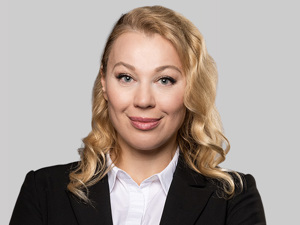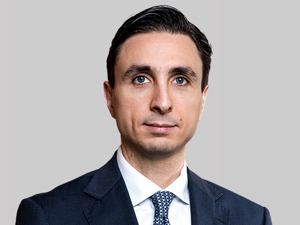East Capital New Europe fund gained 16 % during the quarter, outperforming the benchmark by 1.5%. The key movements across our markets were the very strong performance of Poland (+31%), Greece (+24%), and Hungary (+18%). At the same time, we saw correction in Türkiye (-10%), which was the best alpha attributor in the period due to our underweight position.
On the macro front, we observed inflation in the CEE in the range of 2.7-5.6% during the quarter, with some rebound visible in Hungary, where the government decided to introduce price cuts on food and is considering banking fees and telecommunication price cuts. Central banks in Hungary and Poland continued their pause, while we saw a 25bps cut in Czechia. Moreover, we have seen 4Q’24 GDP figures in the region, with Czechia at +1.6% YoY, Hungary at +0.4% YoY - both in line with expectations - while Poland was at +2.9% YoY, slightly above expectations. The improved sentiment towards our region was due to the initiation of peace talks between Russia and Ukraine with the help of the USA. We have seen several meetings throughout the period, with some willingness of both sides to reach an agreement, but we still need to wait for the outcome.
Türkiye’s market fell by 10% in Q1, and due to the fund’s UW positions, added 72bps of alpha, majority on selection. Türkiye diverged from the Eastern European rally linked to Ukraine peace hopes, highlighting its domestic focus. Volatility spiked after the arrest of a Turkish opposition leader, causing a 17% drop in stocks in lira terms, before a stabilisation back to near November 2024 levels. This political shock jeopardised Türkiye’s economic recovery, threatening disinflation and delaying rate cuts. The lira, though vulnerable, is proving stronger than in the previous crisis, with better central bank reserves and a narrower current account deficit. The central bank’s actions, including hiking the overnight rate and closing the weekly funding window, stabilised the currency. Meetings with the Turkish Central Bank head and Finance Minister Simsek in London in January confirmed their commitment to policy normalisation. However, lira volatility has deterred some fixed-income and equity investors, slowing inflows that support the lira and curb inflation. The central bank is now expected to miss its year-end inflation targets, with rate cuts likely delayed, though a deeper slowdown might prompt cuts in the second half of 2025. Earnings outlooks remain uncertain, with a strong recovery to previous highs unlikely anytime soon. Top performers in the fund included Enka (+5.5%), Logo Yazilim (-2%), and Do&Co (0.7%), while consumer-exposed Bim dropped by 18.7%. The fund’s defensive positioning in Turkish bonds (8% allocation at the beginning of the period) supported returns, with stable bond returns of 0.4 to -1.4%, which still offers a potential 20% USD annual return. Though seldom used in the fund, the investment team now views fixed-income securities as an appealing choice due to heightened risks in Turkish equity markets in terms of risk adjusted returns.
We saw 60bps of positive alpha from Hungary, with the market up 18%. Among our holdings, OTP Bank gained 24% on the back of good numbers reported and a continued attractive valuation, as the bank trades at 6.3x P/E, 1.2x P/BV, with 20.7% ROE for 2025. Another strong attributor was Magyar Telekom, with the stock up 34% during the period, as 4Q numbers reconfirmed yet again its strong operational performance. Unfortunately, on the last day of March, the Hungarian Minister for National Economy announced that price regulations could be applied to telecoms, with a potential 10% price cut mentioned. We see the news as very negative for Magyar Telekom as it may put pressure on results and dividends, especially in the short-term. We see any government intervention as negative and so we sold out the stock.
During the quarter, we saw strong performance in Georgia, which added 35bps, with our names - the two best-in-class banks - returning 32%. The main driver was the hope of a ceasefire with Russia and therefore a reduction in the geopolitical risk premium, although both banks posted excellent results. We had a great meeting with TBC's CEO and Head of International Operations, where we discussed not only Georgia but also their exciting fintech business in Uzbekistan, which we believe is not reflected in the bank's current valuations. The business is trading at 4.6x 2025 P/E, with 15% earnings growth (driven by Uzbekistan) and 25% RoE. Kazakhstan was slightly weaker, as our main holding, Kaspi, returned -4.1%. The results and guidance were solid, so we believe this largely reflects a risk-off mode, particularly on the Nasdaq, where the company is listed. We spent a lot of time discussing the company’s expansion into Turkey through the acquisition of leading e-commerce platform, Hepsiburada. We believe there is a lot of low-hanging fruit for Kaspi's excellent management team to pick, which will be a key growth driver for the company in the coming years.
Poland experienced the strongest absolute performance, with the market up 31% during the quarter. Improved sentiment on the above-mentioned Russia/Ukraine potential peace deal resulted in a broad-based strengthening of the market. Our holdings performed broadly in line with the benchmark, and we added 5bps of alpha. Among the best attributors, banks recorded a strong run, adding 62bps of alpha, with our holdings Alior up 49%, Pekao up 35%, and PKO BP up 34%. The sector remains attractive due to interest rates staying higher for longer, safe capital levels, attractive (8-11% for 2025) dividend yields, and continued attractive valuations (P/E 6-8x, P/BV 1.3-1.7x for 2025), together with a potential acceleration in volumes on the back of investments. The second significant alpha contributor was consumer discretionary, with CCC up 34% and LPP gaining 19%, adding 70bps of alpha. CCC continued its stellar rally on the back of improving results, and a unique business model (full price and off-price segments in the group), while market consensus seems to still lack belief in the company guidance both for 2025 and mid term. The company successfully completed a share issue during the period, which allows it to simplify the group structure and buy out minority shareholders from the Modivo e-commerce arm. The stock trades at 7.5x EV/EBITDA, with 42% YoY EBITDA growth for 2025. We achieved 45bps of alpha on Diagnostyka, a newly IPOed company and market leader in laboratory diagnostics. The stock price was 27% up from IPO price, and is currently trading at 9.3x EV/EBITDA, with 17% YoY EBITDA growth for 2025.
On the negative side, Orlen didn’t work out for us, with the stock price up 53%, deducting 115bps of alpha on the back of an increased dividend payout and low valuation, which together with high liquidity and basket buying of Polish equities, helped the name. Fundamentally, we see more risks for the company in the case of a Russia/Ukraine peace deal, as there may be attempts to again import oil and gas from Russia, which would put pressure on refining margins, but also on Orlen’s gas segment. The stock trades at 2.9x EV/EBITDA, with 7% DY for 2025, and we remain underweight in the name. Among the worst alpha attributors in the quarter was InPost, as the stock price lost 14% on the back of mounting competitive pressure, as Allegro decided to invest more in their network of APMs (automated parcel machines) and tightened cooperations with InPost competitors. The negative impact is not showing in InPost’s numbers yet, with the stock trading at 8.2x EV/EBITDA, 22% EBITDA YoY growth for 2025, but we believe the sentiment towards the stock may be weak for some time, with risk-reward skewed to the downside in case of some further negative news, so we reduced our position.
As for other countries, we have achieved 16bps of alpha on Raiffeisen, with the stock price up 31%, as one of those that can benefit in the case of an end to the war in Ukraine or any ceasefire, with potentially less pressure related to Russian exposure from regulators and/or an easier path to a disposal of Russian operations. The company (ex-Russia) is attractively valued, as it trades at 5.2x P/E, 0.59x P/BV, with 12% ROE for 2025, and we see potential for a rerating.
Greek holdings returned an impressive 26% gain, adding 19 bps of alpha, driven by macroeconomic tailwinds and standout performers like Alpha Bank (+41.5%) and National Bank of Greece (+29%). The country benefitted from continued economic improvement, with tourism revenues sustaining GDP growth, and unemployment dipping further. German stimulus lifted regional GDP, and rising defence spending boosted defence-related industrials like our Greek holding Theon International, up 97.4% on both widespread expansion and potential backlog growth. Titan Cement (+10.7%) added to gains when its US listing plans progressed, while Optima Bank (+25.9%) capitalised on index inclusions and strong results, with net interest income and loans in Q4 2025 growing 13% and 49% YoY respectively, and 2024 ROTE of 25.1%. Optima will probably be the only Greek banks with EPS growth in 2025, due to strong loan growth. Greek banks remained a bright spot, offering high shareholder remuneration yields (8% projected for 2025) and discounted valuations (ca 30% below Italian/Spanish peers), positioning them well as European stimulus supports regional investment flows. Negative sentiment from 2024’s European political uncertainty has largely dissipated, reinforcing Greece’s turnaround narrative.
Czechia posted the worst performance, and we lost 65bps. We do not own any stock in the country and we saw 24-28% price increases in all three benchmark stocks: CEZ, Komercni and Moneta. We remain sceptical, as in the case of CEZ we do not currently see room for bigger dividend payouts with the windfall tax still in place, and we find the current dividend yield of 4% unattractive. In the case of banks, we believe their valuations of 13-14x P/E, 1.7-2.5x P/B are not very appealing considering ROEs of 13-17% and DY 6-8% for 2025, and we prefer banking exposure in other countries.
The second-worst attribution was recorded in Slovenia, with negative 33bps. The market as a whole was very strong over the period, and while our only holding, NLB, recorded a strong 15% price performance, it added only 1bps of alpha. We continue to like NLB on potential strong volume growth in the region for the coming years, with an attractive valuation of 5.8x P/E, 0.8x P/BV and ROE of 14.7% for 2025, offering 9.5% DY. On the other hand, we lost on UW positions in Krka and Petrol, the stocks up 28% and 41%, respectively. We maintain our UW positions in those names, with Krka trading at 9x EV/EBITDA, with 6% YoY EBITDA growth and 5% DY for 2025, which we don’t see as attractive.
We remain optimistic and continue to look for the best selection of high-quality stocks, demonstrating growth and strong balance sheets. East Capital New Europe fund fund is trading at an undemanding 8x P/E, with 14% YoY earnings growth, and offering 4% dividend yield for 2025. We believe a potential end to the Russia/Ukraine conflict would further reduce risk premiums and yields, and support equities in the region. On the other hand, we see potentially increased volatility due to the US tariffs being implemented around the world. While the potential direct negative impact on CEE seems to be limited at 0.2-0.5% of GDP, we are waiting for more details and responses from countries in our regions to assess the full impact.
Performance in USD net of fees.
This publication is not directed at you if we are prohibited by any law in any jurisdiction from making this information available to you and is not intended for any use that would be contrary to local laws or regulations. Every effort has been made to ensure the accuracy of the information, but it may be based on unaudited or unverified figures or sources. The information should not be used as the sole basis for an investment. Please read the Prospectus and the KID, which are available on the fund page.












